4.1 Fabric register
The cultural significance of the lighthouse resides in its fabric, and also in its intangible aspects, such as the meanings people ascribe to it, and the connections to other places and things. The survival of its cultural value depends on a well-informed understanding of what is significant, and on clear thinking about the consequences of change. The Burra Charter sets out good practice for conserving cultural significance.
Below, each part of the lighthouse is listed and the description, condition and significance of each part is discussed. Criterion listed under ‘Heritage Significance’ refer to the criterion satisfied within the specific Commonwealth heritage listing (see ‘Section 5.1’).
Lighthouse feature: Lantern roof
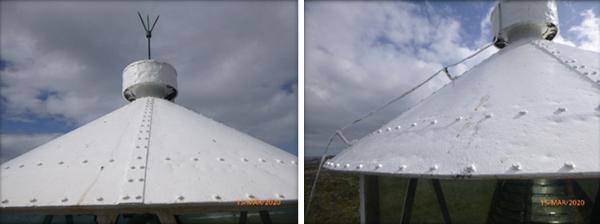 © AMSA 2020
© AMSA 2020
Description and condition
1950 conical roof of copper sheets lapped and riveted. Built with single skin (no internal lining). Supported on circular ring of cast iron segments bolted together. There is no gutter – the roof sheets have a stiffener along the eaves of half-round gutter is formed around the edge of the roof, with holes to allow water to escape – no provision for down pipes. Central drum shaped vent, with circular internal drip tray. Vent has been fully or partly sealed off above the roof. No provision for weather vane.
- Inner skin – none
- Ventilator – drum type
- Lightning conductor – forked lightning conductor on top of vent
- Gutter – none
- Drip tray – circular copper dish suspended under ventilator
| Finish | painted |
| Condition | intact and sound |
| Integrity | high |
| Significance | moderate |
| Maintenance | keep in service, prepare and repaint at normal intervals |
| Rectification works | none |
Heritage significance: Moderate
The lantern roof is an original feature of a lighthouse associated with the ongoing development of navigational aids during the 20th century (criterion a).
The lantern roof is an original feature of a lighthouse associated with the post-war development of Botany Bay as a major port for Sydney (criterion a).
The lantern roof contributes to the aesthetic value of the lighthouse (criterion e).
Lighthouse feature: Lantern glazing
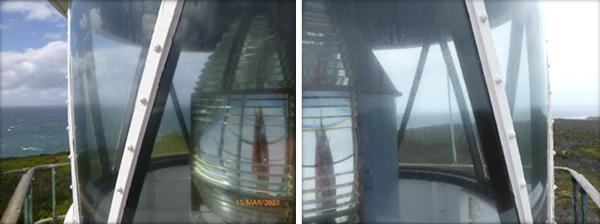 © AMSA 2020
© AMSA 2020
Description and condition
1950 Robison Bros & Co, cylindrical in form. All glazing is clear – no blank panes.
- Panes – curved trapezoidal panes of glass, single tier.
- Astragals – astragals of rectangular section galvanized steel bolted to roof support ring at the top, and to lantern base below.
| Finish | astragals and cover strips painted |
| Condition | intact and sound |
| Integrity | high |
| Significance | moderate |
| Maintenance | keep in service, reglaze as necessary, prepare and repaint at normal intervals |
| Rectification works | none |
Heritage significance: Moderate
The lantern glazing is an original feature of a lighthouse associated with the ongoing development of navigational aids during the 20th century (criterion a).
The lantern glazing is an original feature of a lighthouse associated with the post-war development of Botany Bay as a major port for Sydney (criterion a).
The lantern glazing contributes to the aesthetic value of the lighthouse (criterion e).
Lighthouse feature: Lantern base
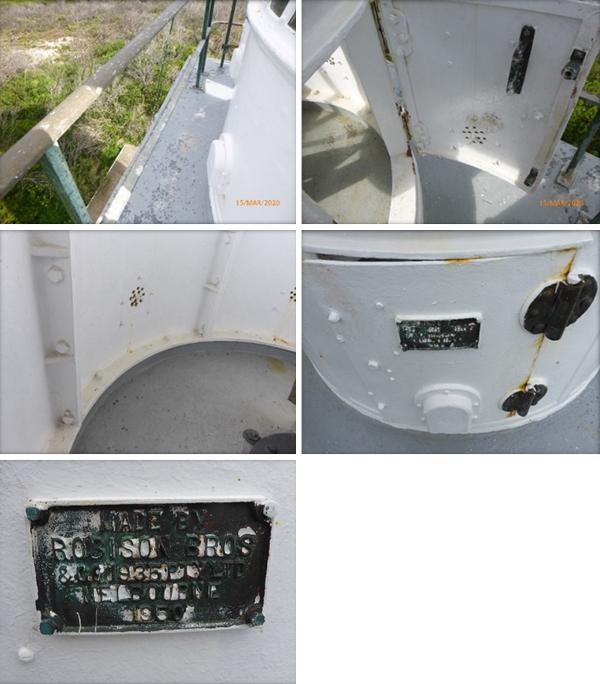 © AMSA 2020
© AMSA 2020
Description and condition
1950 Robison Bros & Co, cylindrical in form. Curved segments of cast iron bolted together with flanged joints.
- Internal lining – none
- Vents – vents have external cast iron cowls with openings downward; air enters through multiple holes drilled through the lantern base – cast non-ferrous metal regulator disks have been removed for maintenance, and are in the spares cupboard on ground floor. Metal hand-holds are fixed to the internal lantern base above the access hatch in the lantern floor.
- Door – balcony access door is of curved steel plate with fittings screwed and bolted to it, fitted with non- ferrous hinges, internal handle, internal finger screws, external maker’s plate.
| Finish | all ferrous painted |
| Condition | intact and sound |
| Integrity | high |
| Significance | moderate |
| Maintenance | keep in service, prepare and repaint at normal intervals |
| Rectification works | none |
Heritage significance: Moderate
The lantern base is an original feature of a lighthouse associated with the ongoing development of navigational aids during the 20th century (criterion a).
The lantern base is an original feature of a lighthouse associated with the post-war development of Botany Bay as a major port for Sydney (criterion a).
The lantern base contributes to the aesthetic value of the lighthouse (criterion e).
Lighthouse feature: Lantern floor
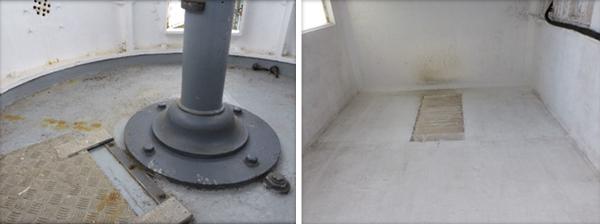 © AMSA 2020
© AMSA 2020
Description and condition
1950 reinforced concrete, with circular concrete upstand to support the lantern base. Hatch cover of aluminium checker-plate hinged to floor.
| Finish | painted |
| Condition | intact and sound |
| Integrity | high |
| Significance | low |
| Maintenance | keep in service, prepare and repaint at normal intervals |
| Rectification works | none |
Heritage significance: Low
Of low significance.
Lighthouse feature: Lens assembly
 © AMSA 2020
© AMSA 2020
Description and condition
1950 Chance Bros 375mm focal radius fixed (non-rotating) lens assembly of glass and gunmetal. Metal access door in one of the landward sectors.
| Condition | intact and sound |
| Integrity | high |
| Significance | moderate |
| Maintenance | keep in service, clean at normal intervals |
| Rectification works | none |
Heritage significance: Moderate
The lens assembly is an original feature of a lighthouse associated with the ongoing development of navigational aids during the 20th century (criterion a).
The lens assembly is an original feature of a lighthouse associated with the post-war development of Botany Bay as a major port for Sydney (criterion a).
Lighthouse feature: Light source
 © AMSA 2020
© AMSA 2020
Description and condition
12V 35W C8 Halogen lamp in CR Control S-2086BLR lamp changer.
| Condition | intact and sound |
| Integrity | high |
| Significance | low |
| Maintenance | keep in service |
| Rectification works | none |
Heritage significance: Low
Of low significance.
Lighthouse feature: Pedestal
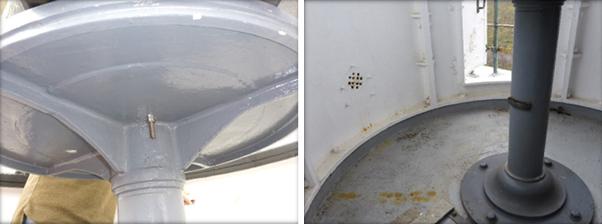 © AMSA 2020
© AMSA 2020
Description and condition
1950 cast ferrous metal pedestal and top.
| Finish | painted |
| Condition | intact and sound |
| Integrity | high |
| Significance | moderate |
| Maintenance | keep in service, prepare and repaint at normal intervals |
| Rectification works | none |
Heritage significance: Moderate
The pedestal is an original feature of a lighthouse associated with the ongoing development of navigational aids during the 20th century (criterion a).
The pedestal is an original feature of a lighthouse associated with the post-war development of Botany Bay as a major port for Sydney (criterion a).
Lighthouse feature: Balcony floor
 © AMSA 2020
© AMSA 2020
Description and condition
1950 reinforced concrete slab continuous with lantern floor, square in plan, with cantilever projection over the supporting walls. Rainwater drains freely over all outer edges. Drip groove cast into edge soffit.
| Finish | painted |
| Condition | some divots from spalling issues, otherwise intact and sound |
| Integrity | high |
| Significance | moderate |
| Maintenance | keep in service, prepare and redo membrane as required |
| Rectification works | none |
Heritage significance: Moderate
The balcony floor is an original feature of a lighthouse associated with the ongoing development of navigational aids during the 20th century (criterion a).
The balcony floor is an original feature of a lighthouse associated with the post-war development of Botany Bay as a major port for Sydney (criterion a).
The balcony floor contributes to the aesthetic value of the lighthouse (criterion e).
Lighthouse feature: Balcony balustrade
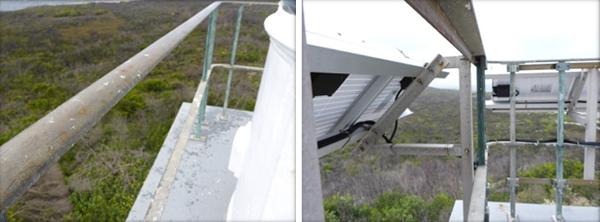 © AMSA 2020
© AMSA 2020
Description and condition
1950 non-ferrous metal solid rectangular bar rails and stanchions, riveted together. Handrail of shaped section. Stanchions fixed to bolts cast into balcony floor.
| Finish | unpainted |
| Condition | intact and sound |
| Integrity | high |
| Significance | moderate |
| Maintenance | keep in service |
| Rectification works | none |
Heritage significance: Moderate
The balcony balustrade is an original feature of a lighthouse associated with the ongoing development of navigational aids during the 20th century (criterion a).
The balcony balustrade is an original feature of a lighthouse associated with the post-war development of Botany Bay as a major port for Sydney (criterion a).
The balcony balustrade contributes to the aesthetic value of the lighthouse (criterion e).
Lighthouse feature: Walls
 © AMSA 2020
© AMSA 2020
Description and condition
1950 reinforced concrete tower, square in plan.
| Finish | painted inside and out |
| Condition | intact and sound |
| Integrity | high |
| Significance | moderate |
| Maintenance | keep in service, prepare and repaint at normal intervals |
| Rectification works | none |
Heritage significance: Moderate
The walls are an original feature of a lighthouse associated with the ongoing development of navigational aids during the 20th century (criterion a).
The walls are an original feature of a lighthouse associated with the post-war development of Botany Bay as a major port for Sydney (criterion a).
The walls are an unique design which contributes to the rarity of the lighthouse (criterion b).
The walls contribute to the aesthetic value of the lighthouse (criterion e).
Lighthouse feature: Windows
 © AMSA 2020
© AMSA 2020
Description and condition
One window in each wall at the upper level; three of these have fixed sheeting over painted glass louvres, the other has a fixed pane of glass. 2018, asbestos fibrous cement sheeting removed and replaced with new fibrous cement sheeting. Broken louvres have been removed from site.
| Finish | painted, except for one fixed pane of clear glass |
| Condition | sound |
| Integrity | moderate |
| Significance | low |
| Maintenance | replace glazing as required |
| Rectification works | none |
Heritage significance: Low
Of low significance.
Lighthouse feature: Door
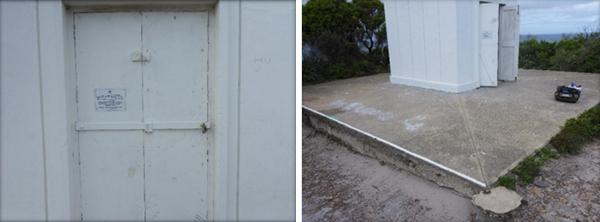 © AMSA 2020
© AMSA 2020
Description and condition
Pair of 1950 timber framed and sheeted doors in timber frame. Faced with steel plate on the outside. Steel locking bar pivoted to one of the doors.
| Finish | painted |
| Condition | intact and sound |
| Integrity | high |
| Significance | moderate |
| Maintenance | keep the doors in service, prepare and paint at normal intervals |
| Rectification works | none |
Heritage significance: Moderate
The door is an original feature of a lighthouse associated with the ongoing development of navigational aids during the 20th century (criterion a).
The door is an original feature of a lighthouse associated with the post-war development of Botany Bay as a major port for Sydney (criterion a).
Lighthouse feature: Mezzanine floor
 © AMSA 2020
© AMSA 2020
Description and condition
Post 1970 plywood floor supported on aluminium beams and brackets bolted to concrete walls.
| Finish | painted |
| Condition | intact and sound |
| Integrity | moderate |
| Significance | low |
| Maintenance | keep in service, prepare and repaint at normal intervals |
| Rectification works | none |
Heritage significance: Low
Of low significance.
Lighthouse feature: Access ladders
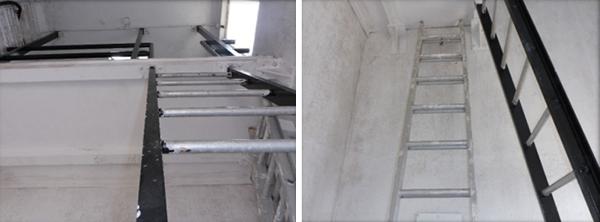 © AMSA 2020
© AMSA 2020
Description and condition
Post 1970 fixed ladders – one from ground floor to mezzanine, and another from mezzanine to lantern. Ladders have aluminium styles and rungs. Non- slip sheeting attached to the rungs.
| Finish | stiles: painted rungs: bare with non-slip sheeting |
| Condition | sound |
| Integrity | moderate |
| Significance | low |
| Maintenance | keep in service, prepare and repaint as required, replace non-slip sheeting as required |
| Rectification works | none |
Heritage significance: Low
Of low significance.
Lighthouse feature: Ground floor
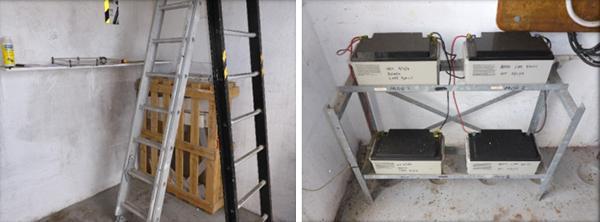 © AMSA 2020
© AMSA 2020
Description and condition
1950 reinforced concrete slab on ground. Depressions to accommodate the bases of acetylene bottles are visible.
| Finish | painted |
| Condition | intact and sound |
| Integrity | high |
| Significance | moderate |
| Maintenance | keep in service, prepare and repaint at normal intervals |
| Rectification works | none |
Heritage significance: Moderate
The ground floor is an original feature of a lighthouse associated with the ongoing development of navigational aids during the 20th century (criterion a).
The ground floor is an original feature of a lighthouse associated with the post-war development of Botany Bay as a major port for Sydney (criterion a).
Lighthouse feature: Apron slab
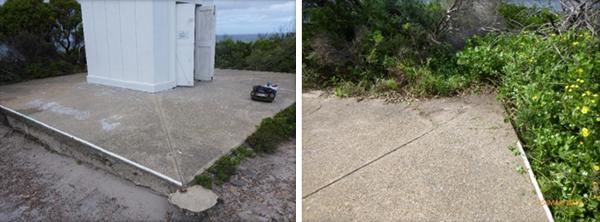 © AMSA 2020
© AMSA 2020
Description and condition
1950 reinforced concrete slab laid on ground, bare concrete finish. The original security fence has been removed, leaving galvanised steel pipe posts in concrete footings flush with the ground.
| Finish | trowelled bare concrete |
| Condition | numerous old cracks in the surface of slab, otherwise intact and sound |
| Integrity | high |
| Significance | low |
| Maintenance | keep in service, investigate cracking in apron slab |
| Rectification works | investigate cracking in apron slab |
Heritage significance: Low
Of low significance.
4.2 Related object and associated AMSA artefacts
There are currently no AMSA artefacts located at Cape Baily Lighthouse.
4.3 Comparative analysis
Cape Baily lighthouse is closest in design to two other AMSA-operated lighthouses, Stokes Point and Cape Liptrap.
Cape Liptrap is located in north-east Victoria and was built one year after Cape Baily in 1951 to replace an earlier 1913 lighthouse. Stokes Point is located on the southern end of King Island, Tasmania. Built in 1952, the lantern room was removed at a later date. Similarly to Cape Baily, Cape Liptrap and Stokes Point are simple square lighthouses
Both Stokes Point and Cape Liptrap vary markedly in design from Cape Baily as can be seen in Figures 17 & 18 below.
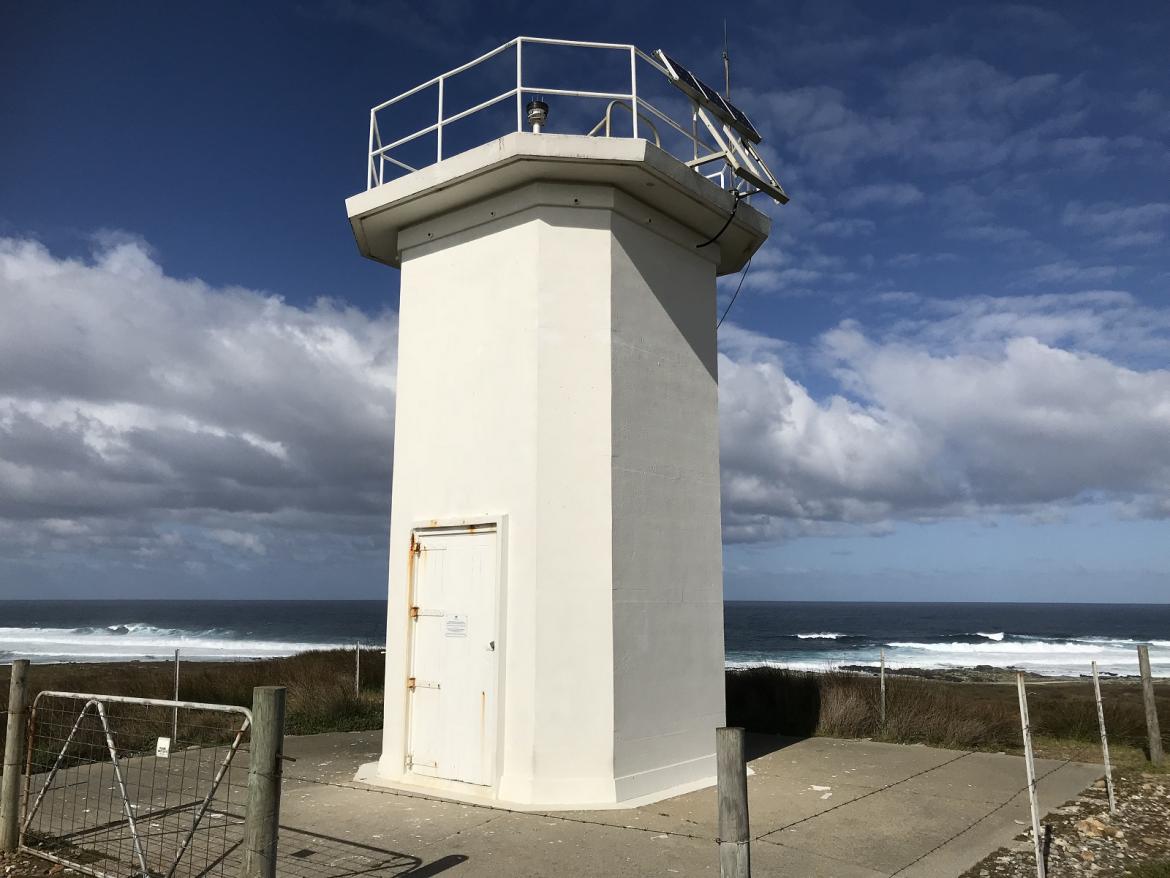 Figure 17. Stokes Point Lighthouse (© AMSA, 2017)
Figure 17. Stokes Point Lighthouse (© AMSA, 2017)
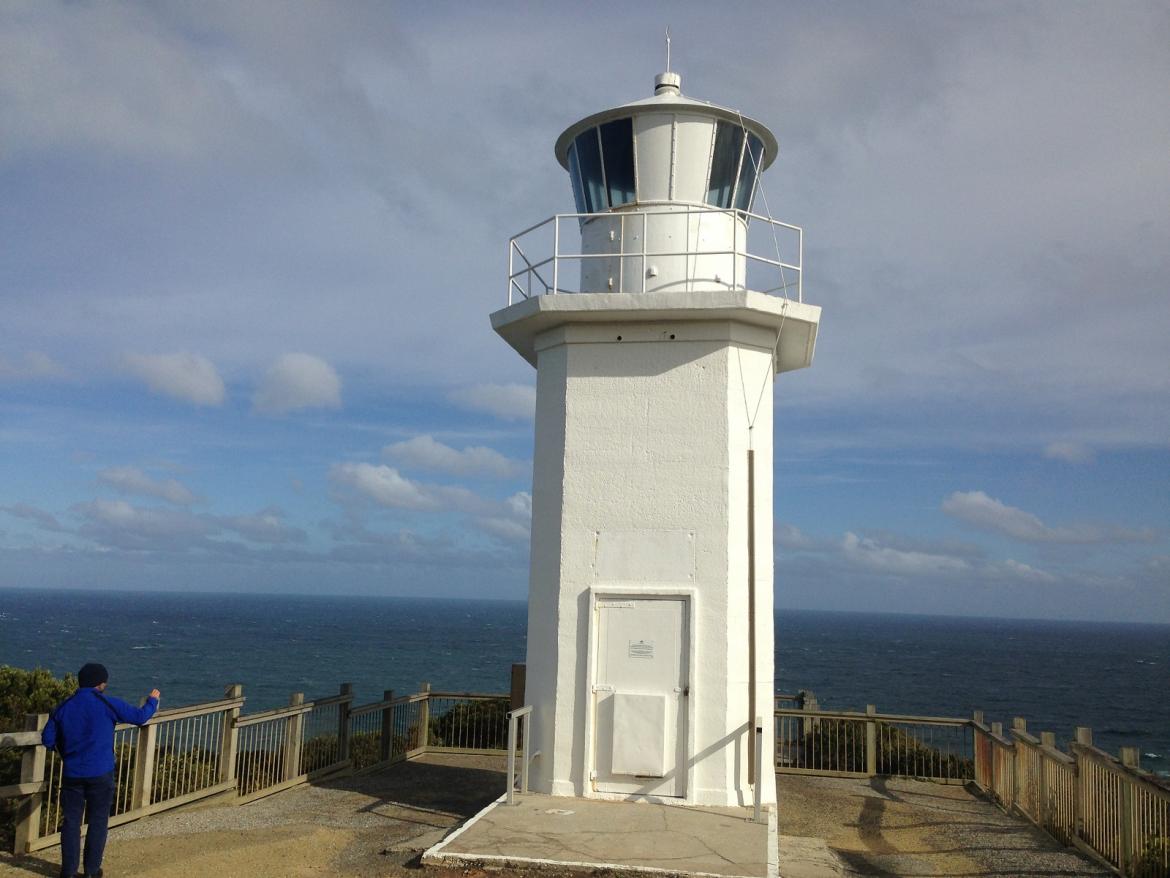 Figure 18. Cape Liptrap Lighthouse (© AMSA, 2013)
Figure 18. Cape Liptrap Lighthouse (© AMSA, 2013)